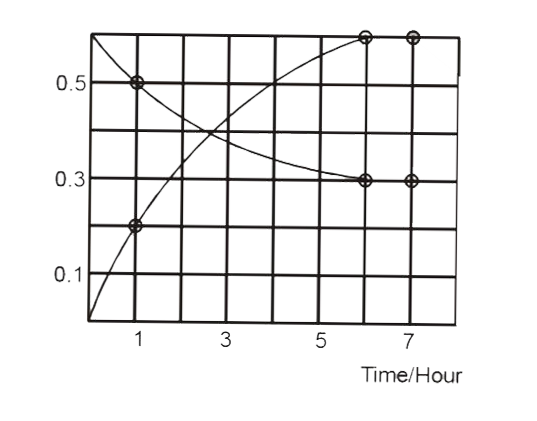The progress of the reaction A⇔nB, with times is presented in the figure below.

Determine:
(a) The value of n , (b) Keq
( c) Initial rate of converison of A
n=2,KC=1.2 , 0.1 M/hr
Topper's Solved these Questions
- CLASSROOM PROBLEMS Book:MOTIONChapter:CLASSROOM PROBLEMS Exercise:Radioactivity
Explore 23 Videos
- CLASSROOM PROBLEMS Book:MOTIONChapter:CLASSROOM PROBLEMS Exercise:Solid State
Explore 18 Videos
- CLASSROOM PROBLEMS Book:MOTIONChapter:CLASSROOM PROBLEMS Exercise:Chemical Kinetics
Explore 30 Videos
- Chemical KineticsBook:MOTIONChapter:Chemical KineticsExercise:Exercise - 4 (Level - II) (SUBJECTIVE PROBLEM)
Explore 1 Video
- CLASSROOM PROBLEMS 1Book:MOTIONChapter:CLASSROOM PROBLEMS 1Exercise:THERMODYNAMICS
Explore 17 Videos
Similar Questions
Knowledge Check
The process of the reaction A⇔nB with time is represented in the fig, given below

The value of n isA1B2C3D1.5The rate law for reaction A+2B⇔C+2D will be :
ARate = K[A][B]BRate =K[A][2B]CRate = K[A][B]2DRate =[C][D]2[A][B]2With respect to the equilibrium reaction A⇔B. Which of the following graphs indicate the highest Kc value ?
A B
B C
C D
D
The progress of the reaction A⇔nB with time, is presented in figure. Determine

the equilibrium constant K.
View SolutionThe progress of the reaction A⇔nB with time is persented in the figure given below:

Determine
a. The value of n.
b. The equilibrium constant K.
c. The initial rate of concentration of A.
View SolutionThe progress of the reaction A⇔nB with time, is presented in figure. Determine

the initial rate of conversion of A.
View SolutionThe progress of the reaction, A ⇌ nB with time, is presented in figure given below. Determine.

(i) The value of n,
(ii) The equilibrium constant K, and
(iii) the initial rate of conversion of A.
View SolutionKp for the reaction A⇔B is 4. If initially only A is present then what will be the partial pressure of B after equilibrium ?
View Solution


